V5 Growth Stage For Corn; Managing Western Bean Cutworm and Armyworms
BY Dairyland Seed Agronomy Team
Corn Plant Development: Importance of the V5 Growth Stage
When a corn plant reaches the V5 stage, it has reached a very important stage in plant development. The importance of the V5 growth stage in corn is that:
- The growing point is above ground and is 1-1½” above the soil surface.
- The plant is determining the number of rows around the cob.
- The nodal root system has become the major root system in the plant.
- Tillers or suckers are starting to form at the base of the plant.
- The plant is starting its above ground growth spurt. With good growing conditions, the corn plant may double its height in 10 to 14-day timeframe.
To use a parental analogy, your corn plant has entered its teenage years.
At the V5-V6 the growing point is about 1-1½” above the soil surface. Plants that break off at or near the soil surface due to hail, sandblasting, mechanical damage (cultivator blight) or other means, will die.
While the growing point is coming out the ground, the number of rows around the cob is being determined. The row count or number of rows around the cob will always be an even number, with 14 to 18 rows around the cob being very common. If the plant is lacking moisture, nutrients due to a deficiency or poor root development, disease, insect damage, or lack of weed control at this stage, the cob will drop rows.
The nodal root system is now the major root system of the plant, with roots being 8 to 12 inches across and 10 to 12 inches deep. If your corn plants were a lighter shade of green (this color has been referred to as the “Ghostbusters” yellow green slime color) prior to V5-V6, with proper available nutrients they should start to green up once the root system finds the nutrients in the soil. If topdressing or sidedressing Nitrogen, or other nutrients, is part of your nutrient management plan, now is a critical time to get it done. Root growth from now until tassel emergence (R1) will be dramatic, as will the above ground growth, with plants potentially doubling in height in the next 10 to 14 days.
It seems as though color differences in specific hybrids or genetic families becomes more apparent at or slightly before that V5 growth stage. This is more apparent when you are in a plot situation and have many hybrids and genetic families to look at.
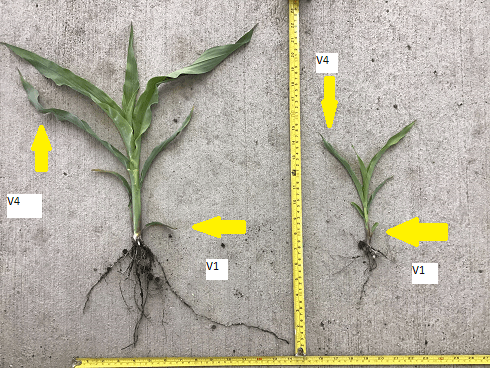
Another important consideration that comes into play at the V5-V6 growth stage is many Crop Protection Product (CPP) labels become more restrictive, either by growth stage or height restriction. As a rule, I tend to follow the growth stage restriction when limiting CPP applications, due to the fact that I can also correlate growth stages by the amount of Growing Degree Units (GDU’s) that we have received since our planting date.
Another reason to choose growth stages over height in making decisions is that different hybrids and/or genetic bases grow or put on height at different rates and can reach the same growth stage with different heights. Or, as in the case of the photo above, due to field growing conditions these two corn plants planted on the same day, in the same field with the same hybrid, are at the same growth stage, V4 but are vastly different heights.
Drought impact on corn
Across certain areas of the Dairyland Seed marketing area, our crops are needing a good drink of water. Yet other areas are receiving those ever-so-important rains. Those not so fortunate are asking questions about the impacts on yield.
In true agronomist fashion the answer is “it depends”. Many factors determine yield and especially so when lack of moisture is involved. Those factors include timing, duration, heat, growth stage, soil type, soil condition and hybrid.
- Did the drought start in early June and is still continuing?
- Was it 95 degrees?
- Is the field sandy or drought-prone to begin with?
- Was the crop “mudded” in and there is severe compaction?
All these factors combine to determine the effects of limited water supply. To compound the issue, the plant nitrogen becomes limited with little water movement. Nitrogen moves via mass flow with soil water through the plant.
Early water stress can have little to no impact and some may say it’s good to be short early in the season. As the corn plant develops, however, this is not the case. We can lose rows around first (V5) and then kernels per row on the ear (V6-V12) as the maturing plant responds to stress. If we can get rain this week, there is a chance the lack of rain will have limited impact. In other areas, there will be more severe yield loss.
WESTERN BEAN CUTWORM
Western Bean Cutworm moth emergence begins in early July and peaks in mid-July. Females will deposit eggs on the uppermost upright leaf of a corn plant either before or right at tassel. Egg masses can range in size from 5 to 200 eggs, but generally number around 50 eggs per group. When the eggs are first deposited, they are white in color and turn to tan and then a blue-purple color just before hatch. The total time for hatch is usually 7-10 days.
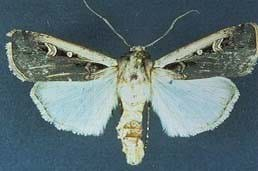
L.J. Capinera. Western Bean Cutworm: Characteristics and Management in Corn and Dry Beans – 5.538. https://extension.colostate.edu/topic-areas/insects/western-bean-cutworm-characteristics-and-management-in-corn-and-dry-beans-5-538/
Areas that have been impacted by Western Bean have a network of pheromone traps usually through University Extension and local co-operators. As trap numbers begin to increase in your area, scouting is necessary. When scouting for Western Bean Cutworm, select 20 plants from 5 different locations in the field. Examine the upper most, not yet unfurled, leaf for egg masses. If 5 percent of plants sampled have egg masses, then control is warranted. Once the eggs hatch, the larvae make their way into the leaf collar and sheath for protection from predators. This hiding also makes them difficult to control with foliar applications, therefore, scouting is crucial to allow for optimal timing of insecticide application.
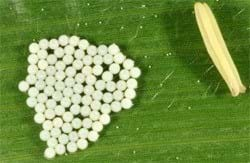
Egg mass next to a corn anther
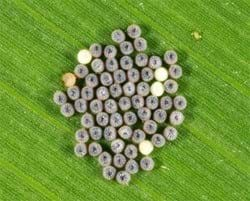
Egg mass close to hatch
J.Obermeyer. Western Bean Cutworm.
https://extension.entm.purdue.edu/fieldcropsipm/insects/western-bean-cutworm.php
The larvae feed on corn pollen, anthers, and leaf tissue all while making their way to their main objective which is the corn ear. Once at the ear, the larvae begin feeding on the developing kernels. This feeding can occur until early October. When mature, the larvae fall to the ground and overwinter in the soil and emerge the following summer. Damage from the feeding can create a vector or entry point for molds and other ear diseases. Losses to feeding and disease have been found to cause up to 30-40 percent yield loss.
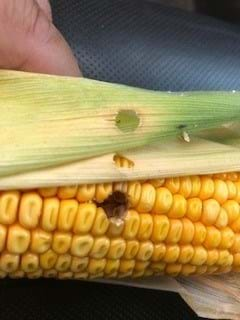
Typical feeding damage from Western bean cutworm
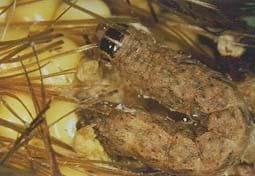
F.B. Peairs. Western Bean Cutworm: Characteristics and Management in Corn and Dry Beans – 5.538.
Management of Western Bean Cutworm is best achieved when scouting is initiated by pheromone trap reports. If egg masses are found on 5 percent of plants sampled, then an insecticide application is recommended. If you have any questions please contact Dairyland Seed DSM or Regional Agronomist for more information.
ARMYWORMS MARCHING IN
Armyworms have been found at threshold numbers in parts of the Dairyland Seed footprint. They have been found feeding on newly-seeded forage crops as well as lawns. The name armyworm is very accurate as they will “march” from field to field. Though few Armyworms overwinter in our area, most pressure comes from moths that move in from southern states. Many impacted fields have a “stemmy” or pale appearance from the road. In most cases damage as low as 10-15 percent defoliation can warrant control measures.
If an insecticide application is warranted, be sure to follow the PHI or Pre-Harvest Interval of your selected insecticide. The PHI is the amount of time that must pass between an application of a pesticide and harvesting of the treated crop. Listed below are a few products that are labelled for armyworm control in alfalfa. If you have any questions, please contact your Dairyland Seed DSM or Regional Agronomist.


Armyworm
|
Product |
Rate |
PHI |
|
Baythroid® XL |
2.8 oz |
7 days |
|
Colbalt® Advanced |
38 oz |
21 days |
|
Fastac® CS |
3.8 oz |
7 days |
|
Grizzly® Too/ Warrior II |
1.92 oz |
7 days |
|
Mustang® Maxx |
4 oz |
7 days |
|
Malathion 5 |
2.25 pt |
0 days |
|
Lambda-Cy |
3.5 oz |
7 days |
 |
 |
 |
 |
 |
| Brian Weller Western Region 507.456.3034 |
Dan Ritter Central Region 219.863.0583 |
Branden Furseth Northern Region 608.513.4265 |
Mark Gibson Eastern Region 260.330.8968 |
Amanda Goffnett Eastern Region 989.400.3793 |
